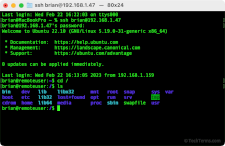Remote User
A remote user is a person that connects to one computer from a different computer. Remote users may connect to another computer over a local network, a virtual private network, or the Internet. Accessing a computer as a remote user requires a user account on the destination computer and remote connection software — either a graphical remote desktop application or a text-based terminal.
Remote users connect to a computer for a variety of tasks. For example, some people may occasionally connect remotely to a work computer from home for a few minutes to access a single file. Other remote users may remotely connect to a computer to configure and maintain server software on it daily. Technical support staff may even remotely connect to another computer at their location to troubleshoot problems.
Windows, macOS, and Unix-like operating systems all include support for remote users. Since Windows primarily uses a graphical user interface, most remote users connect using the Remote Desktop Connection app. Unix and Unix-like operating systems, including macOS, have better support for a command-line-only interface, allowing remote users to connect through a text-based terminal using the SSH protocol.
 Test Your Knowledge
Test Your Knowledge